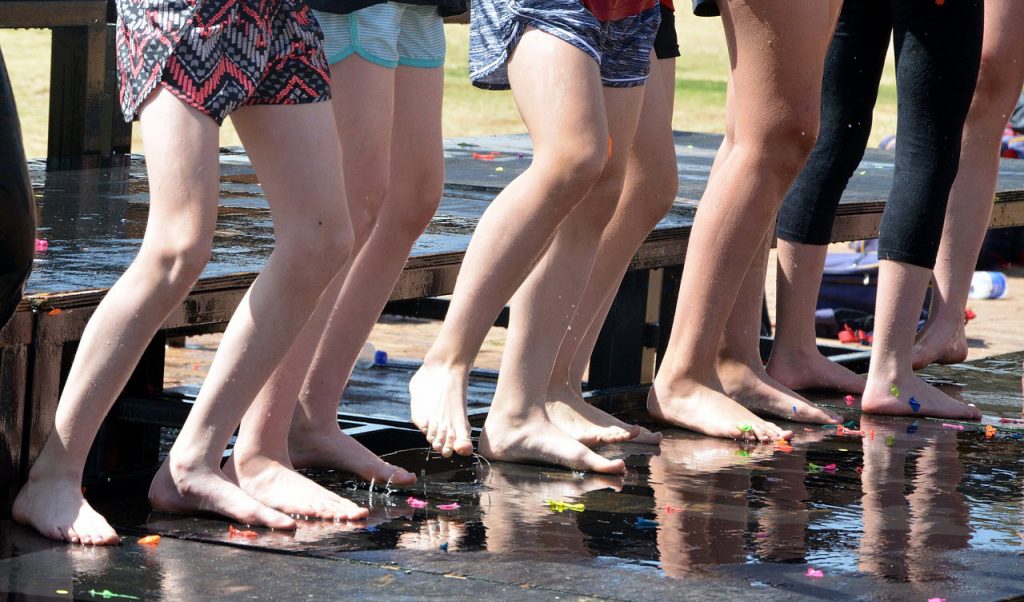
1: Connectedness & Mindfulness
Being barefoot adds a new dimension to how we experience the world. Instead of feeling the inside of your socks and shoes, you will feel the ground surface beneath you.
Being in direct contact with the surface below can also improve mindfulness. You will become more acutely aware of the surface, how it changes, how it feels, and how it impacts your body with each step.
Do you remember running around barefoot as a child? The sensation of green grass or soft sand beneath your feet? The cold touch of patio tiles? Or maybe the scorching heat of a sun-drenched cliff? Yes, the gravel on the pathway hurt a bit during those first days of summer, but you soon developed thicker skin.
2: Lighter strides
A person running barefooted tend to automatically take lighter strides.
With running shoes on, we are heavily buffered from the ground, and this can easily prompt us to take heavy strides which might not be healthy for our bodies since its an unnatural way of running. Heavily buffering and cushioning running shoes is a very modern invention. Just because taking heavy strides feels okay in the moment with your running shoes on it doesn’t mean you aren’t putting undue stress on your feet, ankles and knees.
Take a survey among your running friends and family who run in cushioning running shoes. How many of them have suffered or are suffering from knee cap pain?
3: Correct landing
With running shoes on, it is very easy to fall into a running style where we land heel first (hard heel strikes). If we take a look at how the feet and leg are built, we can see that the configurations are far from ideal for absorbing the shock of heel strikes. Also, people who run with running shoes on tend to strike the ground with the mass of the entire leg – which is approximately 7% of the body. This causes a lot of stress on the foot, ankle, knee, joints and hips.
If you want to run in a more natural fashion, make sure you land on the front or middle of the foot. Studies have shown that running barefoot brings less stress to the feet than running in a pair of expensive high-end “perfect” running shoes. With running shoes on, we tend to shift our weight down to the ankles, thereby increasing the risk of ankle sprain.
N.B! When you first start running barefoot, you might experience some soreness or blistering at the front of the foot, simply because you are not used to landing on it. It is a good idea to adjust gradually to running barefoot. Take it slow and give your body a fighting chance to get used to the new habit.
4: Improved posture
Many runners who make the switch from running shoes to barefoot report improvements in their running posture. The contact between the foot and the ground will allow you to notice quickly if your posture is wrong and your body will strive to correct it more or less automatically.
5: Stronger feet
All that support and constriction provided by your shoes have impacted the development of your feet, increasing the risk of various injuries – including ankle injury. Shoes crush the feet into abnormal positions and prevent them from carrying out the natural movements for which they have developed throughout evolution.
When you are walking and running barefoot, the body recognises the need to change and improve the strength of the feet and of the skin to match this new, and more natural, condition. Tendons and ligaments will stretch to their proper length and muscles needed to support you without shoes will grow stronger.
Without constricting shoes, the feet will also be allowed to develop to their proper size and shape.
Ideally, go barefoot a lot in your everyday life to get the full benefit of this. Running barefoot a few times a week will have less of a positive impact if your feet are constricted by shoes the rest of your waking hours.
6: Increased tactile capacity
Imagine if you always wore gloves. What would happen to the tactile capacity of your hands and finger tips? Now, imagine that you are always wearing shoes when walking, running, hiking, etc. How do you think it impacts the tactile capacity of your feet?
7: Save money
- At the time of writing, Nike has about 1.35 billion shares of publicly traded stock outstanding. A price of around $56 per share puts the value of Nike’s publicly traded shares at around $75 billion.
- In 2011, Asics Corporation generated net sales of approximately 235 billion Japanese yen. This number increased to around 399 billion yen in 2016.
- In 2015, New Balance Athletics, Inc. (NB), reported US$3.7 billion in revenue.

